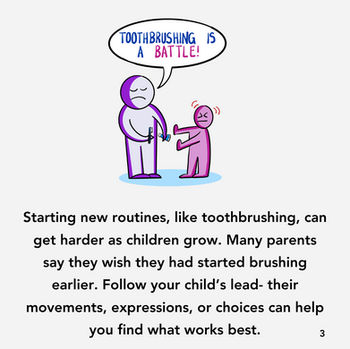
Alternatives to traditional toothbrushes
One step at a time: Building towards using a toothbrush
Using a toothbrush is best, but alternatives can be a good starting point. If your child does not accept a regular toothbrush, use a clean, damp flannel or towel, with fluoride toothpaste to wipe their teeth. Just be aware that these might shed fluff, which your child might not like. Other options include using a clean baby muslin or microfibre towel. Adding toothpaste to one of these can help introduce fluoride into your child’s mouth and protect their teeth.
There are also alternatives to traditional toothbrushes, such as finger toothbrushes, Y-shaped or U-shaped toothbrushes, and NUK brushes (outlined below). These might be more acceptable to some children and might be a good way to start to introduce fluoride toothpaste.
Please note, your child might get attached to using the flannel, towel or alternative brush, which could make it hard to switch to a traditional toothbrush later. We recommend reading 'Tips to introduce toothbrushes' for ideas to help during this process.
Remember, this is a goal towards building a full toothbrushing routine, taking it one step at a time. Hear from Nikki about this.

For some autistic children, these alternative toothbrushes may be useful if:
Your child is young
These types of toothbrushes such as a finger brush can be helpful if your child is under the age of 2.
You are trying to introduce toothbrushing but are unable to use a regular toothbrush
A finger toothbrush could gently introduce the sensation of bristles on to the teeth and gums. They can look less threatening than a toothbrush, are easier to use in an environment other than the bathroom and could be used as part of play. They are also gentler and provide less sensory stimulation than a standard toothbrush. This is a good first option to introduce but other toothbrushes are preferred.
Your child is sensitive to bristles
This is because it can be easier to tolerate when introducing a smear of toothpaste. It's important to remember that if you introduce one of these brushes, it is possible that your child may become fixated on using this type of brush only and it may become difficult to move on to using a regular toothbrush.
Finger toothbrush
These are plastic finger guards with small, soft bristles near the tip. They are often used for babies to introduce them to toothbrushing and can also be used to gently massage the gums. While convenient, a finger brush is not effective for long-term brushing.

Y-shaped or U-shaped toothbrushes
These look like gumshields with silicone bristles, some of these brushes light up and vibrate, claiming to brush all teeth at once. However, there is little evidence supporting their effectiveness. These brushes might be useful for applying fluoride toothpaste, especially if your child doesn’t tolerate other options.
Top Tip
A popular U-shaped brush comes with strawberry-flavoured toothpaste. Be sure to check if this toothpaste contains fluoride, as fluoride is important for protecting teeth. If it doesn't, we recommend switching to a fluoride toothpaste.

NUK Brushes
Designed for young children, these brushes are easy to hold and come with a protective ring to prevent the brush from being pushed too far into the mouth. Find out about NUK brushes here. Like Y-shaped or U-shaped toothbrushes there is little evidence supporting their effectiveness. These brushes might be useful for applying fluoride toothpaste, especially if your child doesn’t tolerate other options.
Key messages

Watch again
Jump straight to what parents and early years professionals have said about different toothbrushes and how you can adapt them.




